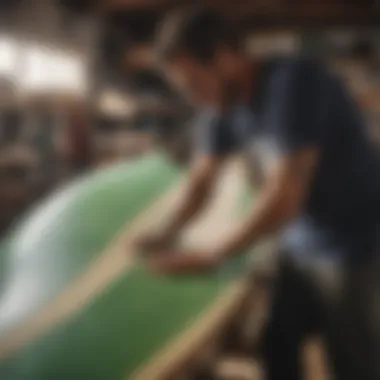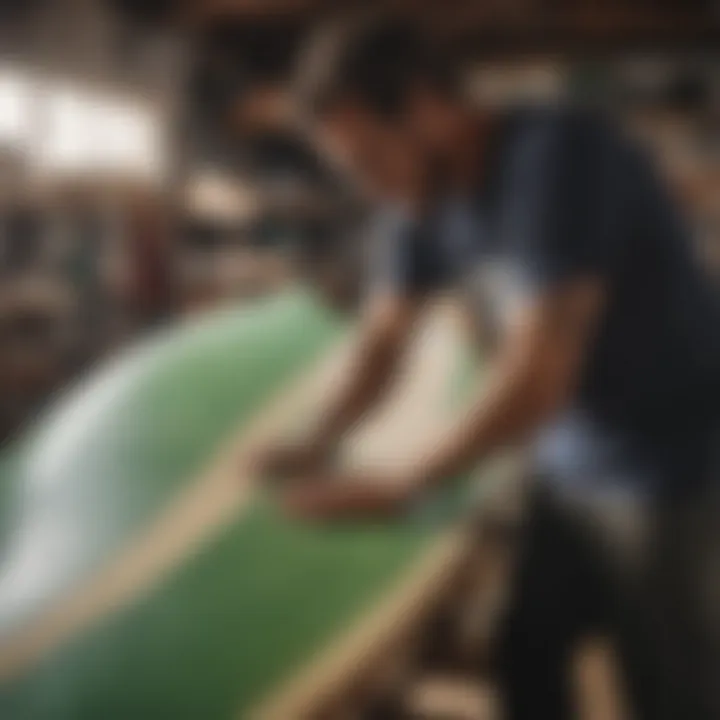An In-Depth Look at Greenlight Surfboard Supply


Intro
In recent years, the surfing community has witnessed a remarkable shift towards sustainability. As surf enthusiasts become more aware of their environmental impact, the demand for eco-friendly surfboard production has surged. This article takes a closer look at one notable player in this emerging landscape—Greenlight Surfboard Supply. By diving into their production methods, material choices, and market trends, we will paint a picture of how this company is shaping the future of surfboard supply while addressing pressing ecological concerns.
The Significance of Sustainable Surfboarding
Surfing is more than just a sport; it's a lifestyle steeped in connection to the ocean and nature. However, traditional surfboard manufacturing often requires materials and processes that can be detrimental to the environment. Greenlight aims to counteract this by adopting practices that are not only innovative but also conscious of the ecological implications. Understanding this shift is essential, not just for surfers but also for anyone invested in the broader conversation about sustainability.
This thorough analysis will explore different aspects of Greenlight Surfboard Supply. We will discuss the production techniques they employ, the benefits of eco-friendly materials, and how the surfing community is responding to these changes.
Moreover, we will delve into how these initiatives influence market demands and, ultimately, the cultural conversation surrounding sustainable surfing practices. By the end of this journey, readers will be equipped with insights that can enrich their surfing experience and contribute to the global endeavor of preserving our waters.
What Lies Ahead
In the sections to come, we will dissect the techniques surfers employ, discuss essential gear, and highlight trends that define the modern surfboard supply chain. Each part will unravel the complexities surrounding Greenlight Surfboard Supply, presenting readers with a nuanced understanding of what makes them a pivotal force in transferring conventional surfing into a more sustainable future.
Intro to Greenlight Surfboard Supply
Understanding Greenlight Surfboard Supply is pivotal for anyone involved in surfing, whether you're a seasoned pro or just dipping your toes in. Surfing, at its core, is not just about catching waves; it’s tied closely with our environment and sustainability practices. Greenlight Surfboard Supply brings these two aspects together, making it an essential component of modern surfing culture.
The importance of this section lies in laying the groundwork for a comprehensive exploration of eco-friendly surfboard production. Here, we’ll consider how the demand for sustainable materials not only shapes industry standards but also carries profound implications for our oceans and beaches. Without a doubt, the methodologies that underpin Greenlight Surfboard Supply are directly linked with broader environmental impacts. As surfers, understanding these connections allows us to make more informed choices.
Defining Greenlight Surfboard Supply
Greenlight Surfboard Supply refers to the array of practices, materials, and technologies employed in the production of surfboards that are geared towards sustainable and environmentally friendly outcomes. Unlike traditional surfboard manufacturing, which often heavily relies on petroleum-based products and generates significant waste, Greenlight Surfboard Supply aims to minimize ecological footprints. This can be achieved through various means, whether it’s the adoption of alternative materials or innovative processes that reduce waste.
To define succinctly, it encompasses:
- Eco-Friendly Materials: Such as bioresins and recycled foams.
- Sustainable Practices: This includes low-waste production methods and renewable resources.
- Community Awareness: Engaging the surfing community in understanding the importance of sustainability.
When we discuss Greenlight Surfboard Supply, we aren't merely talking about the physical boards. We're addressing a shift in culture, one that values the planet while enjoying the thrill of surfing.
The Evolution of Surfboard Design
The journey of surfboard design embodies the transformation of both the sport and its relationship with environmental stewardship. From the early days of wood and heavy materials to today’s sleek, light, and eco-focused designs, the evolution has been nothing short of astounding.
In the late 20th century, surfboards were often made from materials that, while functional, did little to protect the environment—fiberglass and polyurethane dominated the scene. However, as awareness grew, so did innovation. Surf designers began experimenting with alternative materials that offered better performance while being kinder to our earth.
Notable shifts in surfboard design include:
- Introduction of Epoxy Boards: These are lighter and more durable than their predecessors, often utilizing eco-friendlier resins.
- Use of Alternative Materials: Innovations like bamboo and cork have begun to replace traditional substances.
- Functional Eco-Designs: Boards are now often shaped not just for performance, but with sustainability in mind.
This continuous evolution is driven by the dual desire for enhanced performance and a commitment to the environment, illustrating how surfboard design is reflective of broader cultural attitudes toward sustainability.
Materials Used in Surfboard Production
In the realm of surfing, the materials that make up surfboards play a crucial role in their performance and sustainability. This section delves into not just the traditional materials, but also the rising trend of eco-friendly alternatives that are reshaping the industry's landscape. Understanding these materials is essential for surfers who care about both performance and the environment.
Traditional Materials and Their Limitations
Traditionally, surfboards have been crafted primarily from materials like polyurethane foams and fiberglass. While effective in providing buoyancy and durability, these materials come with a hefty environmental price. The production of polyurethane foam involves petrochemical processes that not only consume fossil fuels but also release harmful chemicals into the atmosphere during manufacturing. Furthermore, the foam is not biodegradable, contributing significantly to ocean and landfill pollution.
Another key drawback of traditional surfboard materials is their tendency to wear down over time. Fiberglass layers can crack, and repairs often involve additional toxic adhesives that complicate the sustainability issues further. In essence, while these materials may allow surfboards to perform at a high level, the long-term ecological footprint they leave behind is hard to ignore.
Emergence of Eco-friendly Alternatives
As surfers become more environmentally conscious, eco-friendly materials are stepping into the limelight. This shift is not just a fad; it's a necessity in preserving our ocean ecosystems. Let’s take a closer look at some of the most promising eco-friendly materials transforming surfboard production.
Bioresin Technologies


Bioresin technologies represent a significant leap toward sustainable surfboard production. Unlike traditional epoxy resins derived from fossil fuels, bioresins use plant-based materials, reducing the carbon footprint significantly. The remarkable aspect of bioresins is their ability to maintain structural integrity while being friendlier to the environment.
By incorporating renewable resources, bioresins minimize reliance on petroleum and can yield surfboards that are just as strong, if not stronger, than their traditional counterparts. Moreover, when it comes to end-of-life disposal, boards made with bioresins often have less environmental impact, as they tend to degrade more naturally. This makes bioresin a popular choice among conscientious surfers who prioritize sustainability without compromising performance.
Recycled Foam Core
Another notable eco-innovation is the use of recycled foam cores. Employing materials that have been salvaged from waste and repurposing them for surfboard cores not only diminishes waste but also offers a similar performance level to conventional foam.
The standout characteristic of recycled foam is its ability to retain buoyancy and strength. By using prior foam materials, manufacturers can create surfboards that are much lighter and robust at the same time. However, one must note that the variability in recycled materials can sometimes lead to inconsistencies in quality, making it essential for manufacturers to adhere to strict standards in sourcing.
Sustainable Wood Options
Sustainable wood options also form a segment of eco-friendly materials gaining traction. Utilizing wood from responsibly managed forests, these boards provide a unique aesthetic and natural feel when surfing. The key advantage of wood boards lies in their buoyancy and the potential for craftspersons to customize shapes that traditional materials may not allow.
However, the trade-off is often weight. Wooden boards can be heavier than those made of foam, which may affect performance in certain conditions. Yet, for surfers who appreciate craftsmanship and character in their boards, sustainable wood options may be worth considering despite their drawbacks.
"When you choose sustainable materials, you're not just riding the waves; you're also riding the wave of change for our planet."
The emergence of these innovative materials reflects a broader journey toward sustainability within surfboard production, one that's transforming not only the industry but also how surfers relate to their craft and the environment.
The Manufacturing Process of Sustainable Surfboards
The manufacturing of sustainable surfboards is a topic that resonates well within the surfing community. This process not only affects how the surfboards perform on the waves but also impacts the environment and the well-being of future generations of surfers. With the surf culture leaning towards eco-conscious choices, understanding the nuances of this manufacturing process becomes crucial. Sustainable manufacturing seeks to reduce the carbon footprint and embrace materials that are less harmful to our planet. This section delves into the steps involved in conventional surfboard production before highlighting the innovations that are steering the industry toward sustainability.
Steps in Conventional Surfboard Production
Traditionally, surfboard manufacturing involved a series of well-established steps. The classic method is often seen as a meticulous dance between craftsmanship and chemistry. The usual production processes include:
- Shaping: The starting point where a raw foam blank is cut and molded into the desired surfboard shape.
- Laminating: Once shaped, fiberglass is applied with resin to provide strength and flexibility. This step can release harmful chemicals, especially if standard resin is used.
- Finishing: Sanding and polishing the board gives it a sleek look, but again, involves materials and processes that can affect the environment negatively.
- Artwork: Many boards receive unique art or colors, typically through paints or inks that might contain toxic substances.
While these steps create a functional surfboard, they often come with a price for the environment. The substantial waste produced and the chemicals utilized can be detrimental, thus paving the path for innovations in sustainable manufacturing.
Innovations in Sustainable Manufacturing
The focus on sustainability in surfboard manufacturing has prompted the industry to embrace innovative techniques that not only cater to performance but also align with eco-friendly practices. Below are key advancements worth noting:
3D Printing Techniques
3D printing has emerged as a game changer in surfboard production. This technology allows for the creation of intricately designed boards with precision and minimal waste. A key characteristic of 3D printing in this context is its capacity to fabricate complex shapes without the excess material often generated in traditional methods. For surfing enthusiasts, this means boards can be customized and optimized for personal preference without compromising sustainability. One unique aspect of 3D printing is that it can utilize recycled plastics, further minimizing the environmental impact. However, the technology is still in its infancy for large-scale production, potentially facing challenges in terms of speed and expense in comparison to conventional methods.
Digital Shaping Tools
Digital shaping tools represent another notable advancement. These tools enable shapers to create highly detailed designs while maintaining consistency. The key benefit here is the precision they provide, which leads to better performance on the water. The unique feature of digital shaping lies in its ability to simulate the board's dynamics before physical production begins, saving time and resources. Importantly, these tools can also help reduce material wastage, making the process more eco-friendly. Nonetheless, the effectiveness of the final product can still vary depending on the execution by the shaper.
Zero Waste Approaches
Zero waste approaches focus on minimizing any material discarded during the surfboard manufacturing process. This philosophy promotes the use of every bit of raw material or scrap leftover from production. A key characteristic of this approach is the commitment to sustainability at every step, from the selection of materials to the shaping processes. One of the unique features of these approaches is the shift towards repurposing waste into new products or components for surfboards. This strategy is beneficial as it not only cuts down on waste but also encourages innovation in design and construction. Despite its benefits, implementing a zero waste strategy can sometimes necessitate a significant upfront investment in technology and training, presenting challenges for smaller manufacturers.
The shift towards more sustainable surfboard manufacturing techniques is not just about eco-friendliness; it also opens a new avenue for creativity and performance in surfboard design.
In summary, the manufacturing process of sustainable surfboards is evolving rapidly, spurred by technological advancements and an increased awareness of environmental responsibility. This shift not only promotes better practices within the industry but also caters to the growing demand for eco-friendly products among surfers.
Market Demand for Green Surfboards
The rise in market demand for green surfboards is a reflection of shifting priorities among consumers who are increasingly concerned about sustainability. This trend isn't just a passing phase; it represents a fundamental change in how surfers view their impact on the environment. Eco-friendly surfboards are no longer niche products but are becoming more mainstream, appealing to a broader audience. Manufacturers and retailers must recognize and adapt to this shift in consumer behavior.
Consumer Awareness and Eco-Conscious Choices
In recent years, the dialogue surrounding climate change and environmental degradation has permeated many aspects of life, including surfing. The level of consumer awareness about the harmful effects of traditional surfboard production has escalated. Surfers are now demanding more eco-conscious choices in their equipment.
Research suggests that a significant portion of today's shoppers is inclined to support brands that demonstrate a commitment to sustainability. This awareness has pushed companies to rethink their practices, from sourcing materials to how they market their products. Side by side with this awareness, consumers are keen on product transparency, wanting to know not only the benefits of a product but also its environmental footprint. The popularity of green surfboards can be linked to this growing consciousness that champions eco-friendliness while still appealing to the performance and aesthetics valued by surfers.


Price Dynamics in the Sustainable Surfboard Market
The price dynamics in the sustainable surfboard market illustrate a fascinating contrast to traditional pricing practices. As the demand for green surfboards continues to rise, understanding how price interacts with consumer choices is imperative.
Comparative Pricing
When examining comparative pricing, it's essential to recognize that buyers are often willing to pay a premium for products perceived to be environmentally friendly. Surfboards made from sustainable materials like those crafted using bioresins or recycled foam often come with a higher price tag compared to their traditional counterparts. This aspect of pricing contributes positively to the overall topic as it reflects a trade-off between price and ethical consumption.
The characteristic of comparative pricing is that it emphasizes the distinct qualities of green surfboards, showcasing the benefits they offer. This trade-off is a beneficial choice for those who prioritize environmental impact as much as performance. However, it also raises the question of affordability amid competing offers, which can limit access for some surfers. A major unique feature of comparative pricing is that it often aligns with a surfer's values, thereby supporting a premium market for eco-friendly options while simultaneously raising awareness around sustainability.
Value Perception Among Consumers
An interesting aspect of the value perception among consumers ties back to sustainability. It's not just about the price; it's about what surfers feel their purchase stands for. The value perceived in these surfboards often outweighs the extra cost.
Surfers tend to view sustainable surfboards as investments, equating them with better environmental stewardship. This makes value perception a hallmark characteristic of buying behavior in today's eco-conscious times. A unique feature here is that many consumers interpret value beyond mere functionality; they consider the social implications of their purchase.
This can position a sustainable surfboard as an object that conveys personal ideology and commitment to environmental preservation. As much as consumers appreciate performance, they also cherish the idea of riding a board that embodies their values. Despite these advantages, organizations seeking to promote sustainable surfboards must recognize that some potential buyers might still question their price-to-value ratio, leading to decisions that are less straightforward.
"Understanding market demand for eco-friendly surfboards involves looking at how consumers connect their beliefs with their purchases."
In doing so, brands must balance the needs for sustainability and affordability while enhancing consumer confidence, ensuring that the allure of a sustainable lifestyle isn't just a trend, but a lasting movement embraced by the surfing community.
Surfboard Supply Chain Dynamics
Understanding the surfboard supply chain is crucial for grasping how sustainable practices are integrated into the production of surfboards. The entire process, from raw materials to the hands of the surfers, reflects a commitment to eco-friendly methods. Knowledge of this supply chain allows surfers, manufacturers, and environmentalists alike to make informed decisions, influencing both the market and the environment.
The dynamics of this supply chain include a multitude of factors such as sourcing, manufacturing, and distributing surfboards. Each step plays a pivotal role in determining the ecological footprint of each board produced. The significance of analyzing surfboard supply chains goes beyond simple economics; it showcases how the surfing community is pivotal in driving sustainable practices in the industry.
Production to Retail: Understanding the Supply Chain
The journey of a surfboard begins with sourcing materials that are often harvested with ecological considerations in mind. These materials find their way to manufacturing facilities where skilled artisans and advanced technology converge. Once produced, surfboards travel through various channels before reaching retailers, which can include shops located in coastal areas or online marketplaces catering to surfers globally.
Mistakes or inefficiencies at any of these stages can dampen the efforts of sustainability. Understanding each link in this chain is vital for addressing potential improvements and enhancing the overall environmental impact of surfboard production.
Challenges within the Supply Chain
Logistical Issues
Logistical issues within the surfboard supply chain are often a neglected conversation but they hold considerable weight in the overall efficiency of the process. Transporting bulk materials and finished products can result in carbon emissions that offset the benefits of using sustainable materials. Moreover, the complexity of coordinating deliveries can lead to delays, which frustrate retailers and consumers alike. Conversely, advancements in eco-friendly transportation methods present opportunities for mitigating these issues. By optimizing routes and utilizing greener vehicles, manufacturers can lessen the environmental impact associated with surfboard production.
"Logistics shouldn’t just be about getting products from point A to B; it should also encompass how to do so sustainably," says an industry expert.
Material Sourcing Challenges
Material sourcing challenges are another significant aspect of the supply chain that directly affect sustainability. Finding high-quality, eco-friendly materials can be akin to searching for a needle in a haystack. With limited suppliers offering sustainable options, manufacturers may face a trade-off between quality and environmental considerations.
This challenge is compounded by the growing demand for sustainable boards. As brands strive to meet consumer expectations, they sometimes overlook verifying the sustainability claims of their suppliers. Careful vetting is essential to ensure that the materials sourced are indeed eco-friendly, preserving the integrity of the products. Thus, while focusing on sustainable materials is essential, it also introduces complexity to the sourcing process, requiring manufacturers to remain vigilant and proactive.
In sum, the dynamics of the surfboard supply chain reveal a landscape marked by both opportunities and challenges. By addressing logistical hurdles and material sourcing concerns, stakeholders in the surfing community can work towards a more sustainable future, ensuring that the joys of surfing can be enjoyed by generations to come.
Cultural Significance of Sustainable Surfing Practices
Sustainable surfing practices are not just a trend; they represent a significant cultural shift in the surfing community. This cultural significance is deeply rooted in the values of environmental stewardship and social responsibility that many surfers now embrace. Surfers often view the ocean as more than just a playground; it is a sacred space that demands respect and protection. This shift reflects a growing awareness of the effects that irresponsible practices can have on marine life and coastal communities. The integration of sustainability into surfing culture adds a layer of depth to the sport, creating a community that champions the preservation of the environment.
It's essential to note that this sustainability ethos rejuvenates the traditional surf culture, infusing it with new life while maintaining its central connection to the ocean. The benefits of intertwining sustainability with surfing are numerous, including fostering a sense of community and collective responsibility among surfers, which amplifies the message of environmental protection through shared experiences. By embedding such principles into their lifestyle, surfers are not only making waves on the water but also creating ripples that can lead to ann impactful change in the way society interacts with the environment.
The Intersection of Surf Culture and Environmentalism
The relationship between surf culture and environmentalism is a beautiful, albeit complex, dance. On one hand, surfing relies heavily on nature; the ocean, waves, and beaches are the essential components of the sport. On the other hand, the environmental degradation caused by pollution and overdevelopment poses a direct threat to these vital resources. This intersection encourages surfers to become advocates for conservation and sustainability, often leading to a more profound respect for nature.
Surfers are increasingly aware that their actions have consequences, leading to movements that push for cleaner oceans and beaches. For instance, many local surf communities are creating initiatives aimed at reducing plastic waste, which has been a considerable threat to marine ecosystems. This collective action raises awareness about environmental issues, and the resources that surfers engage with daily spark an underlying dedication to safeguarding these environments.


Community Initiatives and Grassroots Movements
Local Surf Festivals
Local surf festivals have become crucial events in promoting sustainability within the surfing community. These festivals serve as a platform for surfers to gather, celebrate their love for the sport, and engage in eco-friendly practices. The key characteristic of these festivals lies in their ability to blend fun with education. They often feature workshops on sustainable surfing practices and showcase local environmentally friendly businesses, thereby encouraging a shift towards greater eco-consciousness.
Unique features of local surf festivals are the participation of local artists and musicians, along with surf film screenings that highlight environmental issues. While these aspects create a lively atmosphere, they also convey powerful messages about the importance of conserving pristine coastlines. However, the challenge remains in ensuring that the overall impact of these events is genuinely beneficial. If not properly managed, large gatherings could inadvertently contribute to trash and waste. But with organized clean-up efforts, they can turn potential downsides into opportunities for reinforcing community values around sustainability.
Beach Clean-up Drives
Beach clean-up drives have become synonymous with the eco-conscious surfing movement. These drives exemplify action and collaboration, uniting surfers and non-surfers alike for a common goal: to create cleaner, more sustainable coastlines. The distinctive feature of beach clean-up events is their immediate, visual impact. Participants can see the fruits of their labor almost instantly—whether it's collecting plastic bottles, wrappers, or other debris that might otherwise endanger marine life.
Beach clean-up drives are more than just tasks; they build a sense of community and foster connections between participants. They serve as an educational experience that raises awareness about the larger issues of ocean pollution and marine conservation. The advantage of these activities is clear: they encourage ongoing vigilance and a lasting commitment to a cleaner environment. If these drives can become regular events, they can help instill a culture of environmentalism within the surf community.
"Sustainability is not just a practice; it's a lifestyle rooted in respect for the ocean and all it provides."
Future Trends in Surfboard Supply
Understanding future trends in surfboard supply is like peering into a crystal ball that reflects the convergence of innovation, sustainability, and consumer demand. As surfers become more conscious of their environmental footprints, the surfboard supply industry is evolving to meet these expectations. Not only does it advocate for responsible manufacturing practices, but it also embraces technology that enhances performance while minimizing detrimental impacts on the Earth.
This section will highlight how upcoming advancements might reshape how boards are made, marketed, and ultimately enjoyed by surfers who cares about our oceans and coastlines.
Innovations on the Horizon
Looking ahead, a plateau of new technologies and methodologies are emerging, pushing sustainable surfboard production into uncharted waters. For one, the advent of 3D printing is making waves in the surfboard community. This technique allows for more precise designs tailored to individual preferences, reducing waste in the production process. Rather than relying on traditional shaping methods, which can produce excess material, 3D printing can create lightweight yet durable surfboards, offering a seamless blend of performance and environmental mindfulness.
Another exciting development is the integration of advanced biocomposite materials. These materials are made from plant-based fibers, such as hemp or flax, which offer comparable strength to conventional materials but with a significantly lower ecological footprint. When combined with bio-resins, the entire board becomes more eco-friendly from start to finish, steering the industry toward a greener future. This shift not only caters to the eco-conscious surfer but also meets regulatory pressures for more sustainable practices.
Moreover, smart surfing technologies are on the rise. Surfers can expect to see boards equipped with tracking devices, which can analyze wave conditions and personal surf metrics, enhancing the overall experience. The fusion of electronics and surfboards might initially raise eyebrows, but the potential for better performance and environmental insights could potentially transform the sport.
"Innovation is the catalyst for change in the surfing industry, from cradle to wave."
The increasing collaboration between designers, environmental scientists, and tech innovators signals a future where surfboards aren't just rideable pieces of wood and foam but are also integral to the conversation about sustainability.
Adapting to Changing Consumer Preferences
As waves shift in consumer preferences, the surfboard industry finds its sails adjusting to meet new demands. Today’s surfers aren't just looking for performance; they are after a story behind their board. A green narrative can elevate a surfboard from ordinary to extraordinary. Eco-enthusiasts now seek products that reflect their values, leading to a profound shift in purchasing behaviors.
Brands that embrace transparency in their sourcing and production processes will gain a significant edge over competitors. Consumers want to know where materials come from, how they’re produced, and what environmental measures are in place. This rising demand for clarity pushes brands to outline their sustainability journey, emphasizing eco-friendly choices like sustainable woods, recycled foams, and ethical labor practices.
In addition, personalization is becoming paramount. Surfers desire products that resonate with their individual style and preferences, pairing functionality with aesthetic appeal. Offering customizable designs or direct-to-consumer sales can forge a deeper connection between the surfer and the surfboard, resulting in a high-value experience.
Finally, the increasing popularity of social media and online forums, such as those on platforms like reddit.com and facebook.com, has amplified the discourse surrounding sustainable surfing practices. Review platforms encourage brand accountability, enabling consumers to make informed decisions based on peer feedback and experiences.
These shifts are not mere trends; they indicate a broader understanding of the bond between surfing and environmental stewardship, aligning the sport with a greater purpose.
The End: The Road Ahead for Greenlight Surfboard Supply
The world of surfboard supply is riding a wave of change, and as we look into the future, it’s imperative to understand the various currents that shape this landscape. Greenlight Surfboard Supply stands at the forefront of ensuring that surfing is not just a sport, but a sustainable lifestyle. It’s about more than just catching the perfect wave; it’s about preserving our oceans for future generations of surfers. Here, we’ll explore two vital elements that solidify this journey: sustainability and responsible practices.
Sustainability as a Core Principle
Sustainability is no longer just trendy jargon; it’s the bedrock of the surf industry’s evolution. The commitment to eco-friendly materials and manufacturing processes is crucial to minimizing the ecological footprint of surfboards. What’s significant is how brands like Greenlight have started to integrate sustainable practices into every facet of production.
- Material Innovation: Alternatives like bioresins and recycled foam cores are transforming the industry’s approach. These materials not only cut down on waste but also promote a circular economy.
- Energy-Efficient Manufacturing: Implementing technologies that reduce energy consumption during production is a game-changer. The adoption of renewable energy sources can significantly lower the overall carbon footprint.
As surfers shift their preferences towards brands that reflect their values, companies have an opportunity to lead by example. Sustainable practices are essential not just for compliance with regulations, but for fostering a community that values long-term ocean health.
Encouraging Responsible Surfing Practices
The relationship between surfing and the environment is deeply intertwined. Encouraging responsible surfing practices is essential for the wellbeing of our waves and beaches. Here are some practical insights:
- Education Campaigns: Engaging local surf communities through workshops and events can raise awareness around environmental conservation. Grassroots initiatives, such as ocean cleanup days, not only beautify beaches but instill a sense of stewardship among surfers.
- Eco-Friendly Beach Habits: Surfers can adopt habits such as using reusable water bottles, avoiding single-use plastics, and making conscious choices about where to surf. Waving the green flag is about making small, everyday changes that collectively yield significant impact.
"Sustainable surfing isn’t just an option; it’s a responsibility that can define the future of the sport."
In essence, as we surf into the future, it’s important to realize the role our choices play. By embedding sustainability as a core value and encouraging responsible surfing practices, we can hope to ensure that our beloved sport thrives alongside our planet's health. A forward-thinking approach not only protects the waves we ride but also nurtures the vibrant culture of surfing for generations to come.















